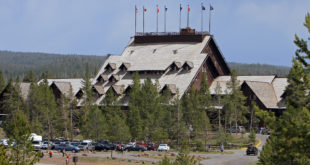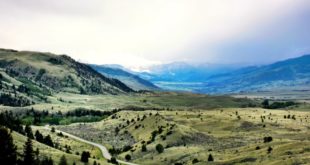Every year about this time (mid-June to the end of July), cutthroat trout of Yellowstone Park begin the search for the waters of their birth. It’s time to spawn – to lay and fertilize eggs in the gravel of streams and rivers so that the cycle of life continues. But it isn’t easy. Two locations make a good example of what the cutthroat go through to continue the species: Trout Lake, near the Northeast Entrance highway and LeHardys Rapids near the Grand Loop Road between Fishing Bridge and Canyon. We picked these two because they’re great places to visit with the kids – living showcases of nature’s way.
LeHardys Rapids is a ‘rough spot’ in the smooth flow of the Yellowstone River as it passes through the southern end of Hayden Valley. If it weren’t for the rapids, the cutthroat trout (Yellowstone’s native species) could swim the placid waters of the river all the way to Yellowstone Lake. But the rapids change everything – from a fishy equivalent of a stroll into a life-and-death struggle. The rapids separate the calm waters in Hayden Valley from the spawning ground at the outlet of Yellowstone Lake, and in order to breed the fish must hurtle themselves into the rock-strewn torrent and literally swim for their lives – and the lives of their offspring. (Map and pictures below the fold.)
 |

Observation platform at LeHardys Rapids |
We’re lucky, there’s an official grandstand for this desperate drama. About 3 miles (5km) north of Fishing Bridge (12.5 miles/20km if you’re coming from Canyon), on the east (river) side of the Grand Loop Road is a parking pullout marked “LeHardys Rapids.” From this parking area, there are flights of wooden stairs down to the level of the river. If the stairs are a problem, another parking pullout (unmarked) just north, has a gradual trail and boardwalk to the same spot on the river. Here the park service has built platforms at the edge of the river with a grand view of the rapids and all the action.
At the height of the run, the cutthroat trout can be seen spurting into the air as they dash through rock and spray. In between the dashes, they pool up – sometimes in the thousands – to rest. In years when the river has unusually high water (as in 2008), only a few fish tempt the flood and these you’ll see making their way along the rocks of the shoreline; almost under your feet. Most of the fish will wait until later in the summer when the river subsides.

Yellowstone River |
LeHardys Rapids
|

Spawning cutthroat trout |
This is an all or nothing run for many of the fish. They either make the spawning grounds, or die from exhaustion trying. If they make it, the gently flowing river waters of Yellowstone Lake’s outlet cover the gravel beds necessary for spawning. The female fish each deposits thousands of eggs into the gravel, which are then blanketed by the male fish with ‘milt’ a gelatinous substance that contains the sperm that fertilize the eggs. It’s a hazardous process; not only the run of the rapids, but also the claws of bears, eagles, ospreys, otters and other predators await the successful swimmers. Of the millions of fish eggs deposited, only a tiny percentage hatch into fingerling fish (called fry), and of those as juicy morsels of food for birds and other fish, only a small percentage survive to adults. But this process of reproduction has been going on for millenia, and in Yellowstone you can see how it works almost unchanged in all that time.
Trout Lake is less dramatic. There is no visible life and death struggle for the fish. Here there is something else at work – a slow but possible end of the species.
Trout Lake nestles on a ‘bench’ or natural shelf area below the Absaroka mountains of the northeast Yellowstone Park. You can reach it along the Northeast Entrance Road, about 18 miles (29km) from the Tower-Roosevelt Junction with the Grand Loop Road, or 11 miles (17km) from the Northeast Entrance (Cooke City/Silver Gate). There’a a signed parking pullout big enough for about eight to ten vehicles on the north side of the highway. From the parking spot, a trail leads off to the left, past an information sign, and then up (and up, and up), climbing about 150 feet (50m) in elevation in half a mile (800 m). The trail’s a tad steep and may not be for everyone, but it’s mercifully short. There’s an obvious bison wallow, a big bare-spot and depression, right next to the parking area and trail – ignore the occupant, if there is one.
In most weather, the lake and its setting is gorgeous, one of the most photogenic small lakes in the park; but we’re here for the fish. So are the fishermen – and thereby hangs the tale. Trout Lake has long been a fishery, in fact, the park service operated a fish hatchery here from 1919 to 1950. It was called Fish Lake then. Before that, the good miners of Cooke City came to the lake for a supply of fish, sometimes using explosives to get them. Fortunately, the lake is big enough and wonderfully endowed with underwater plant life to support a very large number of fish. At first the lake had native cutthroat trout, and that’s what the park service took from the hatchery. However, in 1934 it was decided that rainbow trout was a better ‘game fish’ and rainbows were planted in Trout Lake for the hatchery. The rainbow trout did well, at least as well as the cutthroat trout in the lake. The thing is, however, that the rainbow trout are not native to Yellowstone National Park; and the park’s mandate included preserving the native species. Worse, the rainbow trout are genetically close enough to cutthroat trout so that the two species can inter-breed. The result is a rainbow-cutthroat hybrid, called a ‘cuttbow’. Eventually, the lake would be filled with the hybrid, and there would be no more native cutthroat.

Trout Lake in northeast Yellowstone Park |

Rainbow trout in Trout Lake |
Over the years park service policy toward non-native fish has changed. Today, with the native cutthroat trout in trouble (inching toward the endangered species classification because of the lake trout infestation of Yellowstone Lake), the policy is to protect the cutthroat with ‘catch and release’ fishing, but allow fishermen to keep a limited number of other species. This is the case at Trout Lake, where rainbow trout may be caught and kept – if you can catch one. The rainbow in this lake are notorious for rejecting everything the two-legged predators throw into the water. Of course, it’s hoped that the rainbow will be fished out, eventually.

Cutthroat pool before spawn
|

Trout Lake inlet stream |

Cutthroat running the inlet |
Meanwhile, a short hike around the lake to the north end inlet, will bring you to the spot where literally hundreds of fish – mostly cutthroat about 12-18 inches in length – are gathered near the inlet waiting for the right moment to enter the stream and make the short run to the spawning beds. In the clear water of the lake and stream, it’s like a marvellous natural aquarium, a place to quietly observe the fish in action. If you’re lucky, an osprey or the resident otter will make an appearance to catch a fish, and create a mighty uproar among the pooling swimmers. Given the beautiful surroundings, the puff-and-grunt to get there, and the fascination of the spawning multitude – take a picnic lunch along, and set a spell (hopefully with the kids) to appreciate this story of the struggle for reproduction.
 Yellowstone Insider Your Complete Guide to America's First National Park
Yellowstone Insider Your Complete Guide to America's First National Park






